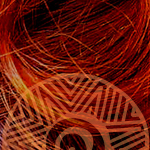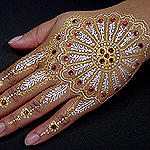|
Lel Hanna "the Night of the Henna" copyright Catherine Cartwright-Jones c 2003 Kent State University The bride's and groom's parents invited villagers to "the night of the henna" that preceded the wedding. Invitations to wealthy guests said: "Come to the dyeing in the house of the bride, please cook". This implied that the wealthy should bring food to the wedding feast. Invitations to poor people specified that they did not need to bring food to the party. Women hennaed a young boy before the party began. A young girl worked up the henna paste for the groom, and the family put the hennaed child on the groom's lap. This child was a decoy for malevolent spirits and the evil eye that might try to harm the groom. The evil eye would pounce on the boy, mistaking him for the groom, but the henna protected the child from harm. The child stayed in the groom's lap as people hennaed the groom. First they hennaed the groom's right hand and left foot, then the left hand and right foot. The henna patterns were wrapped when they had dried. When the groom's henna was finished, his male friends and relatives at the party had henna too. The groom's family celebrated and feasted during his henna. When this was completed, the family, friends and groom went to the bride's house, where she had her night of the henna, to continue celebrating and feasting. Go to The Jewish Kurdish Bride's Night of the Henna Each Jewish village and family had slightly different traditions. In Sinne, women hennaed the fronts and backs of the groom's hands, then his hair. The next morning, the groom went in a procession to bathe at the river or the local bathhouse, later in the morning than the bride's procession. When he was bathed, he dressed, but left his shirt unbuttoned until he consummated his marriage. His friends put roses in his belt and sprinkled rose water over him. He borrowed a dagger from the Muslim Kurds to put in his belt, to protect him from the evil eye, and from an aggressive bride! He returned from the river dressed in his wedding finery, and he went with his procession to the bride's house, and to begin the wedding day celebrations. Additional material on Kurdish Jewish marriage traditions is in "The Jews of Kurdistan" by Eric Brauer. References:
Return to Kurdistani
Jewish Henna Traditions Index
Can't find what you want here? Try The Henna Page Main Index. |
| This information is provided free to you through the support of Becoming Moonlight®, Mehandi.com, and Ancient Sunrise®, Please keep this website free of pop-up advertising by visiting our sponsors. |
 Click HERE or on the image above to go shopping for henna and body art supplies. |
Email info@mehandi.com |  Click HERE for information on henna for hair. Click HERE for FREE books and videos about henna for hair | Click HERE for FREE | |
 Friend and follow us on Faceboook! Our Facebook group includes Henna Page® FB page Mehandi FB page Empire LLC FB page Bittersweet's LLC FB page Ancient Sunrise® group Becoming Moonlight® page Becoming Moonlight® group TapDancing Lizard® LLC |  The Henna Page® is an educationalresource devoted to the history,traditions, techniques, science and art of henna. The articles are written by Catherine unless otherwise noted. | FREE henna e-books from TapDancing Lizard® Books on the history, traditions, science, and art of henna and related arts! |






